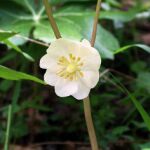| Common Name: | American Mandrake |
| Other Names: | Duck’s Foot, Hog Apple, Mandrake, Mayapple, Raccoon Berry, Wild Lemon |
| Botanical Name: | Podophyllum peltatum |
| Genus: | Podophyllum |
| Family: | Berberidaceae |
| Cultivation: | Rich, moist soil, pH4.0-7.0, in sheltered semi-shade. Young leaves may be damaged by frost in cold areas. |
| Propagation: | By seed sown when ripe at 20°C (68°F); by division in spring or late summer. |
| Harvest: | Rhizomes are lifted in autumn, and dried for use in tinctures and for commercial extraction of resin. |
| Native Location: | NE America |
| Height: | 30-45cm (12-18in) |
| Width: | 1.2m (4ft) |
| Hardiness: | Z3-9 |
| Parts Used: | Rhizomes, resin extracted from rhizome |
| Properties: | An acrid, caustic herb with an unpleasant smell. It has anti-cancer and anti-viral effects, and is a drastic purgative. |
| Medicinal Uses: | Internally for certain cancers. Externally for venereal warts and plantar warts.
To treat warts, fever, snakebite, and syphillis; and as a laxative. Germany’s Commission E has approved the use of mayapple to treat warts. |
| Typical Dose: | A typical dose of mayapple root may range from 1.5 to 3.0 gm per day, applied to the skin. |
| Possible Side Effects: | Mayapple’s side effects may include severe skin irritation. |
| Drug Interactions: | | Taking mayapple with these drugs may increase the risk of hypokalemia (low levels of potassium in the blood: | | Acetazolamide, (Apo-Acetazolamide, Diamox Sequels) | Azosemide, (Diat) | Bumetanide, (Bumex, Burinex) | Chlorothiazide, (Diuril) | | Chlorthalidone, (Apo-Clorthalidone, Thalitone) | Ethacrynic Acid, (Edecrin) | Etozolin, (Elkapin) | Furosemide, (Apo-Furosemide, Lasix) | | Hydrochlorothiazide, (Apo-Hydro, Microzide) | Hydroflumethiazide, (Diucardin, Saluron) | Indapamide, (Lozol, Nu-Indapamide) | Mannitol, (Osmitrol, Resectisol) | | Methazolamide, (Apo-Methazolamide, Neptazane) | Methyclothiazide, (Aquatensen, Enduron) | Metolazone, (Mykrox, Zaroxolyn) | Olmesartan and Hydrochlorothiazide, (Benicar HCT) | | Polythiazide, (Renese) | Torsemide, (Demadex) | Trichlormethiazide, (Metatensin, Naqua) | Urea, (Amino-Cerv, UltraMide) | | Xipamide, (Diurexan, Lumitens) |
| Taking mayapple with these drugs may decrease the laxative effects of the herb: | | Belladonna and Opium, (B&O Supprettes) | Belladonna, Phenobarbital, and Ergotamine, (Bellamine S, Bel-Tabs) | Ipecac, () |
|
| Lab Test Alterations: | May decrease red blood cell concentrations. |
| Disease Effects: | May worsen gastrointestinal ailments by irritating the gastrointestinal tract. |
| Food Interactions: | Increased laxative effect of mayapple when used concurrently with salt. |
| Supplement Interactions: | - Increased risk of cardiac glycoside toxicity when used with other herbs that contain cardiac glycosides, such as Black Hellebore, Calotropis, Motherwort, and others.
- Increased risk of potassium depletion when used in conjunction with Horsetail Plant or Licorice.
- Increased risk of potassium depletion when used with other stimulant laxative herbs, such as Black Root, Cascara Sagrada, Castor Oil, and Senna.
- Decreased laxative effect of mayapple when used concurrently with Hyoscyamus, Leptandra, or Lobelia.
|
| Warning: | All parts, except ripe fruits, may be fatally toxic if eaten. Handling may cause systemic poisoning.
Contraindicated during pregnancy
This herb is subject to legal restrictions in most countries.</B< |
| Bibliography: | Encyclopedia of Herbs by Deni Brown. Copyright © 1995, 2001 Dorling Kindersley Limited. pp 324-325
The Essential Herb-Drug-Vitamin Interaction Guide by Geo. T. Grossberg,MD and Barry Fox,PhD Copyright©2007 Barry Fox,PhD. Pp. 337-338 |

